
Mathemagics Workbook
.pdf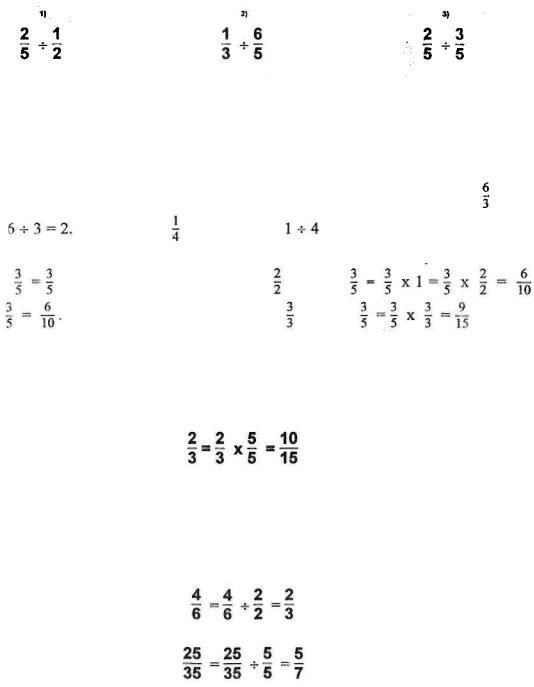
Exercises
Now it's your turn. Divide these fractions,
Simplifying Fractions |
|
|
|
|
Fractions can be thought of as little division |
problems. For instance, |
is the |
||
same as |
The fraction |
is the same as |
, (which is .25 in decimal form). |
|
Now we know that when we multiply any number by 1, the number stays the same. For
example, |
x 1. But if we replace 1 with |
, we get |
|
Hence, |
Likewise, if we replace 1 with |
, we get |
. In other |
words, if we multiply the numerator and denominator by the same number, we get a fraction that is equal to the first fraction.
For another example,
It is also true that if we divide the numerator and denominator by the same number, then we get a fraction that is equal to the first one.
For instance,
This is called simplifying the fraction.
43
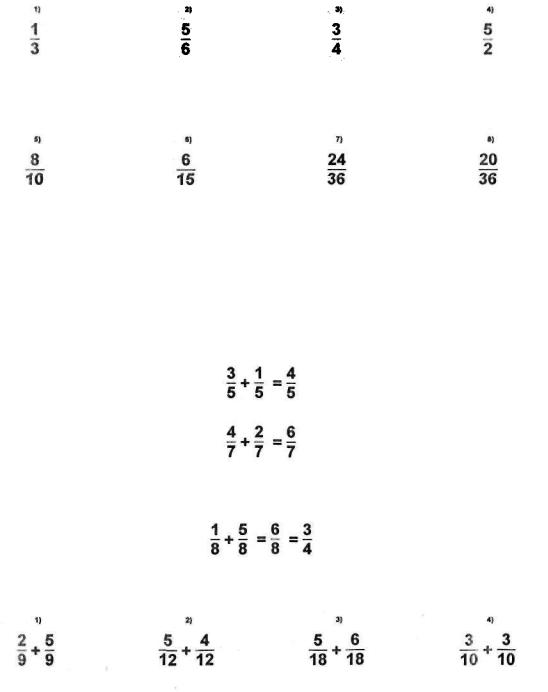
Exercises
For the fractions below, can you find an equal fraction whose denominator is 12?
Simplify these fractions.
Adding Fractions
The easy case: Equal denominators. If the denominators are equal, then we add the numerators and keep the same denominators.
For instance,
Sometimes we can simplify our answer. For instance,
Exercises
The trickier case: Unequal denominators. When the denominators arc not equal, then we replace our fractions with fractions where the denominators are equal.
44
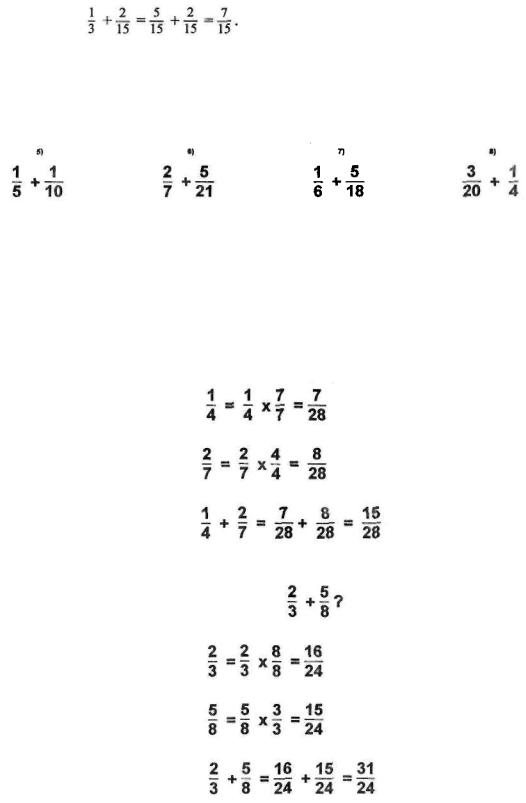
For instance, to add  , we notice that
, we notice that 
Therefore
To add  , we see that
, we see that  , hence
, hence
Exercises
The problems in the last exercise were made easier because the smaller denominator divided into the larger one. But what if that's not the case? How would we
add something like  ? The trick is to create a common denominator by multiplying the top and bottom of each fraction by the other denominator. For example,
? The trick is to create a common denominator by multiplying the top and bottom of each fraction by the other denominator. For example,
Thus
How about
Thus
45
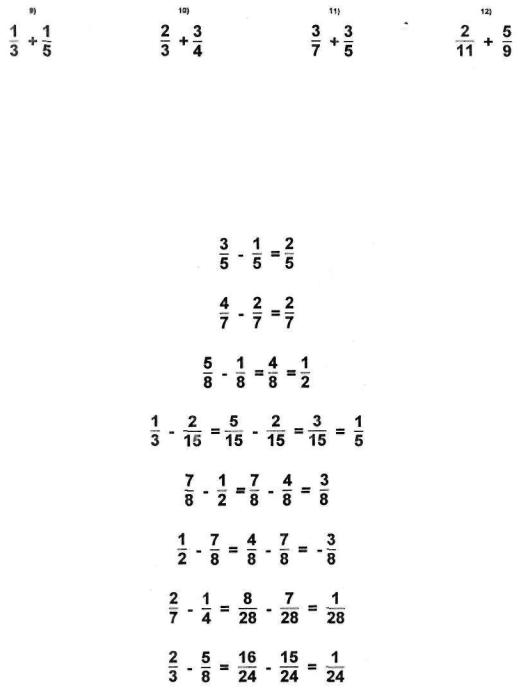
Exercises
Subtracting Fractions
Subtracting fractions works very much like adding them. We illustrate with exampl and provide exercises for you to do.
46
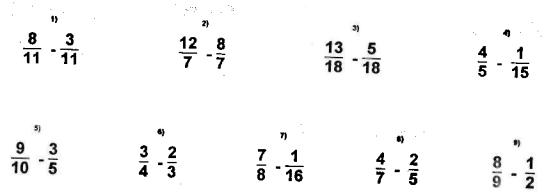
Exercises
47
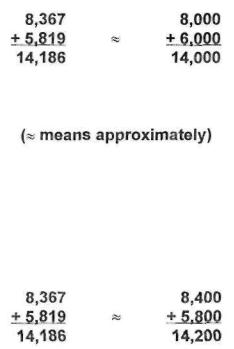
CHAPTER 5
THE ART OF "GUESSTIMATION"
So far, you have been perfecting the mental techniques necessary to figure out the exact answers to math problems. Often, however, all you will want is a ballpark estimate. Say you're getting quotes from different lenders on refinancing your home. All you really need at this information-gathering stage is a ballpark estimate of what your monthly payments will be. Or say you're settling a restaurant bill with a group of friends and you don't want to figure each person's bill to the penny. The guesstimation methods described in this chapter will make both these tasks—and many more just like them— much easier. Addition, subtraction, division, and multiplication all lend themselves to guesstimation. As usual, you will do your computations from left to right.
Addition Guesstimation
Guesstimation is a good way to make your life easier when the numbers of a problem are too long to remember. The trick is to round the original numbers up or down:
Notice that we rounded the first number down to the nearest thousand and the second number up. Since the exact answer is 14,186, our relative error is only  , or
, or
1.3%.
If you want to be more exact, instead of rounding off to the nearest thousand, round off to the nearest hundred:
49
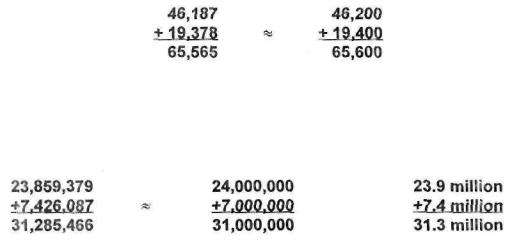
The answer is only 14 off from the exact answer, an error of less than . 1 % . This is what I call a good guesstimation!
Try a 5-digit addition problem, rounding to the nearest hundred:
By rounding to the nearest hundred our answer will always be off by less than 100. If the answer is larger than 10,000, your guesstimate will be within 1%.
Now let's try something wild:
or
If you round to the nearest million, you get an answer of 31 million, off by roughly 285,000. Not bad, but you can do better by rounding to the nearest hundred thousand, as we've shown in the right-hand column. In this case you're off by only 15,000, which is awfully close when you're dealing with numbers to the third digit of the larger number (here the hundred-thousand digit), your guesstimate will always be within 1% of the precise answer. If you can compute these smaller problems exactly, you can guesstimate the answer to any addition problem.
Guesstimating at the Supermarket
Let's try a real-world example. Have you ever gone to the store and wondered what the total is going to be before the cashier rings it up? For estimating the total, my technique is to round the prices to the nearest 500. For example, while the cashier is adding the numbers shown below on the left, I mentally add the numbers shown on the right:
50
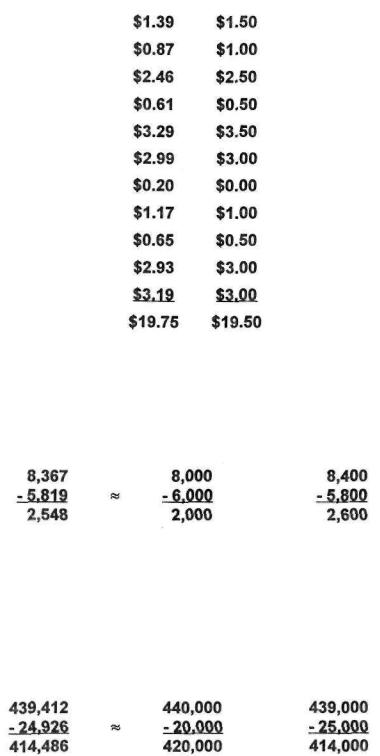
My final figure is usually within a dollar of the exact answer.
Subtraction Guesstimation
The way to guesstimate the answers to subtraction problems is the same—you round to the nearest thousand or hundreds digit, preferably the latter:
or
You can see that rounding to the nearest thousand leaves you with an answer quite a bit off the mark. By rounding to the second digit (hundreds, in the example), your answer will usually be within 3% of the exact answer. For this problem, your answer is off by only 52, a relative error of 2%. If you round to the third digit, the relative error will usually be below 1%. For instance:
or
By rounding the numbers to the third digit rather than to the second digit, you improve the accuracy of the estimate by a significant amount. The first guesstimate is off by about 1.3%, whereas the second guesstimate is only off by about 0.16%.
51
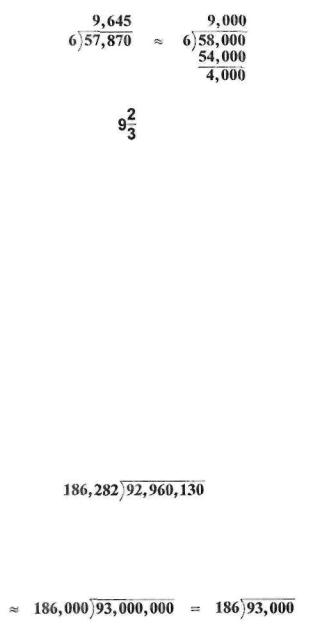
Division Guesstimation
The first step in guesstimating the answer to a division problem is 10 determine the magnitude of the answer:
The next step is to round off the larger numbers to the nearest thousand and change the 57,870 to 58,000. Dividing 6 into 58 is simple. The answer is 9 with a remainder. But the most important component in this problem is where to place the 9.
For example, multiplying 6 x 90 yields 540, while multiplying 6 x 900 yields 5400, both of which are too small. But 6 x 9000 = 54,000, which is pretty close to the answer. This tells you the answer is 9 thousand and something. You can estimate just what that something is by first subtracting 58 - 54 = 4. At this point you could bring down the 0 and divide 6 into 40, and so forth. But if you're on your toes you'll realize that dividing 6 into 4 gives you 
 = .667. Since you know the answer is 9 thousand something, you're now in a position to guess 9667. In fact, the actual answer is 9645— darn close!
= .667. Since you know the answer is 9 thousand something, you're now in a position to guess 9667. In fact, the actual answer is 9645— darn close!
Here's an astronomical calculation for you. How many seconds does it take light to get from the Sun to the Earth? Well, light travels at 186,282 miles per second, and the sun is (on average) 92,960,130 miles away:
1 doubt you're particularly eager to attempt this problem by hand. Fortunately, it's relatively simple to guesstimate an answer. First, simplify the problem:
Now divide 186 into 930, which yields 5 with no remainder. Then tack back on the two zeros you removed from 93,000 and voilá—your answer is 500 seconds. The exact answer is 499.02 seconds, so this is a very respectable guesstimate.
52

Multiplication Guesstimation
You can use much the same techniques to guesstimate your answers to multiplication problems. For example,
Rounding up to the nearest multiple of 10 simplifies the problem considerably, but you're still off by 252, or about 5%. You can do better if you round both numbers by the same amount, but in opposite directions. That is, if you round 88 by increasing 2, you should also decrease 54 by 2:
Instead of a 1-by-l multiplication problem you now have a 2-by-l problem, which should be easy enough for you to do. Your guesstimation is off by only 1.5%.
When you guesstimate the answer to multiplication problems by rounding the larger number up and the smaller number down, your guesstimate will be a little low. If you round the larger number down and the smaller number up so that the numbers are closer together, your guesstimate will be a little high. The larger the amount by which you round up or down, the greater your guesstimate will be off from the exact answer. For example:
Since the numbers are closer together after you round them off, your guesstimate is a little high.
Since the numbers are farther apart, the estimated answer is too low, though again, not by much. You can see that this multiplication guesstimation method works quite well. Also notice that this problem is just 67' and that our approximation is just the first step of the squaring techniques. Let's look at one more example:
53
